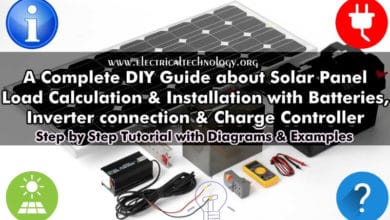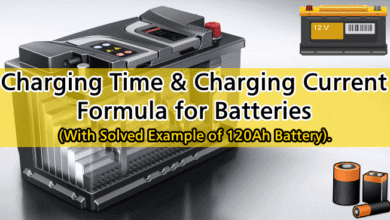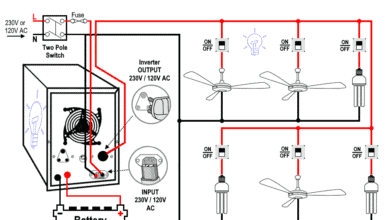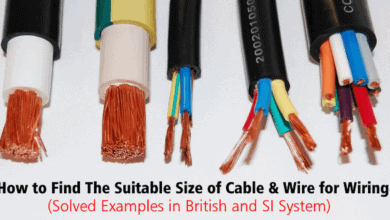How to Size Grounding Electrode Conductor (GEC)?
What is Grounding Electrode Conductor? Sizing GEC for Grounding in AC Systems
For a proper grounding system, the following step-by-step guide can be used to determine the suitable size of grounding electrode conductor (GEC) for alternating current (AC) systems based on NEC 2023 (Article 250.66 and table 250.66).
What is GEC?
The Grounding Electrode Conductor (GEC) is a component of electrical grounding system used for protection against faults and electric shock hazards. In electrical grounding and earthing, the GEC is connected between the common point (bonded terminal of ground and neutral inside the main panel box) and ground rod.
According to the National Electrical Codes (NEC), a Grounding Electrode Conductor (GEC) is a conductor used to connect the system grounded conductor or the equipment to a grounding electrode or to a point on the grounding electrode system.
The NEC neither requires nor prohibits the use of color green for the identification of grounding electrode conductors (GEC). NEC – 250.119(A), 250.62 and 250.64.
Purpose of the GEC
A Grounding Electrode Conductor (GEC) is used to connect the grounding electrode system (such as ground rods, concrete-encased electrodes, or metal underground water pipes) to the electrical system’s grounding point.
The primary function of GEC is to provide a low-impedance path to the earth for fault currents and to stabilize voltage levels. NEC 250.4(A)(1) – General grounding requirements.
- Related Post: How to Size Equipment Grounding Conductor (EGC)?
- In the U.S. (NEC), the Grounding Electrode Conductor (GEC) is referred to as the Earthing Lead in BS 7671 and IEC-compliant countries. The function and purpose are the same; only the terminology differs.
The terms GEC and EGC can be a bit confusing for beginners and new apprentices.
- GEC (Grounding Electrode Conductor) connects the common neutral-ground busbar in the main panel or disconnect switch to a grounding electrode, such as a ground rod or an earth plate buried in the ground. The sizing of the GEC is determined based on Article 250.66 and Table 250.66 of the NEC.
- EGC (Equipment Grounding Conductor) serves as a bonding wire, connecting the exposed metal parts of electrical equipment and devices to ensure safety by providing a low-resistance path for fault currents. The sizing of the EGC is determined based on Article 250.122 and Table 250.122 of the NEC.
Sizing Grounding Electrode Conductor
The NEC 2023 provides guidelines on GEC sizing based on the largest ungrounded service-entrance conductor or equivalent area for AC systems.
This tutorial will guide you through the process of sizing a GEC using Article 250.66 and Table 250.66 from the National Electrical Code (NEC) 2023.
The size of the GEC is determined based on the largest ungrounded service-entrance conductor or equivalent conductor area. You need to determine:
- Service conductor type (Copper or Aluminum)
- Size of the largest ungrounded service conductor
- If the system uses parallel conductors, the total equivalent cross-sectional area must be calculated. NEC 250.66(A), (B), and (C) for special conditions
Once you identify the largest ungrounded conductor size (see the following examples), use Table 250.66 in the NEC 2023 to determine the minimum required GEC size.
- The minimum required size of an Equipment Grounding Conductor (EGC) should not be less than 8 AWG copper or 6 AWG aluminum / copper-clade aluminum. 250.166.
Special Conditions and Exceptions for GEC
There are special conditions where a full-sized GEC may not be required:
- For rod, pipe, and plate electrodes, the maximum required GEC size is 6 AWG Copper or 4 AWG Aluminum. NEC 250.66(A)
- For Concrete-Encased Electrodes (Ufer Ground), the maximum required GEC size is 4 AWG Copper – 250.66(B)
- For grounding ring, the minimum required GEC size is 2 AWG Copper – 250.66(C)
When service conductors are in parallel, use the combined equivalent size to determine the correct GEC size. For example, two 2/0 AWG Cu conductors per phase → Equivalent to 4/0 AWG Cu total, so the GEC must be at least 4 AWG Cu.
GEC Sizing Table
The minimum grounding electrode conductor size based on 250.66 table is given below.
| Largest Ungrounded Conductor or Equivalent (Copper/Aluminum or Copper-Clad Aluminum) | Size of Grounding Electrode Conductor (GEC) | ||
| Copper | Aluminum or Copper-Clad Aluminum | Copper | Aluminum / Copper-Clad Aluminum |
| 2 AWG or Smaller | 1/0 AWG or smaller | 8 AWG | 6 AWG |
| 1 or 1/0 AWG | 2/0 or 3/0 AWG | 6 AWG | 4 AWG |
| 2/0 or 3/0 AWG | 4/0 or 250 kcmil | 4 AWG | 2 AWG |
| Over 3/0 AWG through 350 kcmil | Over 250 kcmil through 500 kcmil | 2 AWG | 1/0 AWG |
| Over 350 kcmil through 600 kcmil | Over 500 kcmil through 900 kcmil | 1/0 AWG | 3/0 AWG |
| Over 600 kcmil through 1100 kcmil | Over 900 kcmil through 1750 kcmil | 2/0 AWG | 4/0 AWG |
| Over 1100 kcmil | Over 1750 kcmil | 3/0 AWG | 250 kcmil |
| NEC Table 250.66 – Sizing Grounding Electrode Conductor for AC Systems | |||
Here is the GEC sizing table in the image format for reference.

Examples of GEC Sizing and Calculations
Article 250.66 and Table 250.66 in NEC 2023 are used to properly size a Grounding Electrode Conductor (GEC) for AC system based on the largest ungrounded service-entrance conductor. Consider the following solved examples.
Example 1: The required size of main breaker in the main panel is 100-amp based on Table – 310.12(A) and 310.15(B)16 – NEC. What will be the suitable size of grounding electrode conductor (GEC)?
Solution:
Based on the determined size of 100-amp main breaker for a single story dwelling unit, the required size of service entrance or feeder to the subpanel is #4 AWG copper or #2 AWG aluminum (NEC – Table 310.12(A for Sizing Service/Feeders).
To determine the correct size of grounding electrode conductor (GEC) for 100-amp panel, refer to the NEC Table 250.66.
Therefore, the required ground wire size is #8 AWG copper or #6 AWG aluminum or copper-clade aluminum for #4 AWG copper or #2 AWG aluminum service feeding a 100-amp main panel.
Example 2: The total load of a 1500 ft2 (139.35 m2) residential building is calculated as 150-amp and the required service entrance cable is #1 AWG Copper or #2/0 AWG Aluminum. What is the correct size of GEC is needed for 150-Amp supply system?
Solution:
As the step by step load for load center/main panel is already calculated which is 150-amp. The size of the service entrance is determined based on NEC – Table 310.12(A) which is #1 AWG Copper or #2/0 AWG Aluminum.
Now, refer to the Table 250.66 to determine the size of size of grounding electrode conductor (GEC) for 150-amp panel.
Hence, the required size of GEC is #6 AWG copper or #4 AWG aluminum or copper-clade aluminum for #1 AWG copper or #2/0 AWG aluminum service supplying a 150-amp main panel.
Example 3: What is the required size of GEC for 200A Service with Copper Conductors?
Solution:
2/0 AWG Copper as service entrance conductors are required for 200-Amp panel (NEC – Table 310.12(A). For Over 1/0 AWG to 3/0 AWG Copper, the minimum required GEC size is 4 AWG Copper (NEC – Table 250.66).
Example 4: What is the suitable size of grounding electrode conductor for 400A Service with parallel conductors.
Solution:
- Service Entrance Conductors: Two sets of 3/0 AWG Copper (parallel) are used for 400-amp panel.
- Equivalent size: (3/0 AWG × 2) = 250 kcmil copper Equivalent
- For over 3/0 AWG to 350 kcmil copper, the minimum required GEC size is 2 AWG copper. (Table 250.66).
Example 5: What is the appropriate size of grounding electrode conductor for 600A Service with Aluminum Conductors?
Solution:
- Service Entrance Conductors: 600 kcmil Aluminum
- For over 500 kcmil to 900 kcmil Aluminum, the minimum required GEC size is 3/0 AWG Aluminum. (Table 250.66).
Related Post: Grounding and Methods of Earthing in PV Solar System
NEC Requirement for GEC
- According to NEC, copper, aluminum, or copper-clad aluminum (CCA) can be used for grounding electrode conductors (GECs).
- The grounding electrode conductor (GEC) must be connected to the neutral conductor at any accessible location (such as meter box in the service point, service disconnect or ground and neutral bonded busbar in the main panel) for the service point to the service disconnect. Section 250.24(A)(1), (B), (C)(4) & Section 250.28.
- A grounding electrode conductor (GEC) is used to connect the equipment grounding conductors (GECs), service equipment enclosures, and, if the system is grounded, the grounded service conductor to the grounding electrode(s) as required by Part III of Article 250.24.
- Grounding electrode conductor (GEC) termination is required for service equipment supplied from a grounded system. 250.24(A)
- The recommended way to connect the GEC and main bounding jumper (MBJ) together to the same point i.e. to the grounding busbar in the main panel or disconnect.
- All grounding electrode conductors (GECs) shall be installed in accordance with 250.64(A), (B), (C), and (E).
- If GEC is exposed to physical damage or the size of GEC is smaller than 6 AWG, protect it with raceway (e.g., intermediate, PVC or metal conduit). 250.64(B).
- Splicing the GEC is not allowed except through NEC-permitted methods i.e. Use irreversible crimp connectors or exothermic welding for connections of GEC, EGC and bonding. NEC 250.64(C).
- Keep the GEC as short and direct as possible based on length and routing. NEC 250.64(F).
- Aluminum GEC cannot be in direct contact with the earth or installed in concrete. NEC 250.64(A).
- Multiple buildings with separate grounding and GEC systems must be bonded at a common point and connected to a single grounding electrode system.
Resources and Related Posts:
- Difference Between AC Ground and DC Ground?
- Difference Between Grounding, Earthing and Bonding
- Difference Between Neutral, Ground and Earth?
- Can you Combine AC and DC Ground in a Solar Installation?
- Will I Get an Electric Shock If I Touch the Ground Wire?
- Why Doesn’t DC System Require a Grounding System Similar to AC System?
- Why is the Grounding Wire Bare and Not Insulated?
- Why is the Ground Wire Size Smaller than the Hot Wire?
- Why is the Ground Wire Always Positioned Above the Overhead Power Lines?
- Why Must Neutral and Ground Wires Be Bonded in the Main Panel?
- Why are Neutral and Ground Wires Separated in a Subpanel?
- Why are Salt and Charcoal Added in Earthing Pit for Grounding?
- Difference Between GND, 0VDC, Common and Virtual Ground
- Is It Possible to Get Electrocuted by an Electric Vehicle?
- How Does the Grounding System Work in Aircraft & Submarines?








